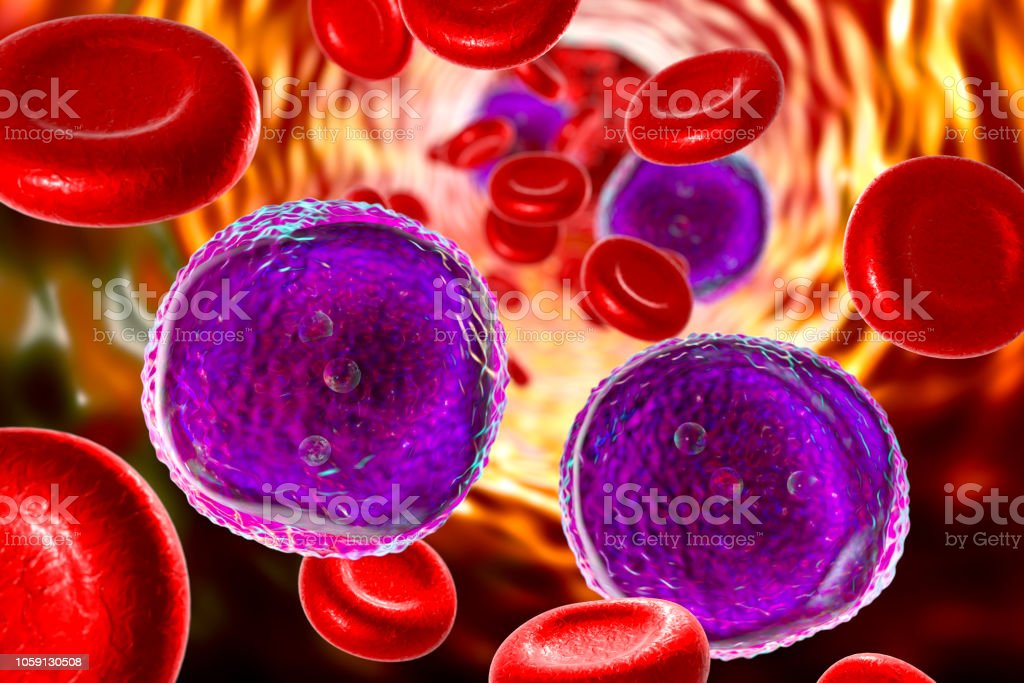
It is a type of cancer that affects the blood and bone marrow, causing an abnormal increase in the number of white blood cells. The condition can be acute or chronic, and it is characterized by the abnormal production of immature white blood cells, called blasts. These cells do not function properly, and they can crowd out healthy blood cells, leading to a range of symptoms and complications.
Patient presentation of Leukemia
Patients with leukemia may present with a variety of symptoms, which can vary depending on the type of leukemia they have, the stage of the disease, and other factors.
Some common symptoms of leukemia include:
- Fatigue or weakness
- Fever or chills
- Frequent infections
- Unexplained weight loss
- Loss of appetite
- Swollen lymph nodes, liver, or spleen
- Easy bleeding or bruising
- Petechiae (tiny red spots on the skin)
- Bone pain or tenderness
- Joint pain
- Headaches
- Shortness of breath
Types of Leukemia
There are several types of leukemia, and the treatment options vary depending on the type and stage of the disease. The most common types of leukemia include
- Acute lymphoblastic leukemia (ALL)
- Acute myeloid leukemia (AML)
- Chronic lymphocytic leukemia (CLL)
- Chronic myeloid leukemia (CML).
Acute lymphoblastic leukemia (ALL) is a type of cancer that affects the blood and bone marrow. It is the most common type of cancer in children, but it can also occur in adults. ALL is a cancer of the white blood cells, specifically the lymphocytes, which are responsible for fighting infections in the body. In ALL, abnormal lymphocytes are produced in the bone marrow and rapidly multiply, crowding out normal blood cells. This can lead to a decrease in the number of healthy red blood cells, white blood cells, and platelets in the body.
Acute myeloid leukemia (AML) is a type of cancer that affects the blood and bone marrow. AML is characterized by the rapid growth of abnormal white blood cells that accumulate in the bone marrow and interfere with the production of normal blood cells. The abnormal white blood cells, or myeloblasts, are immature and do not function properly, leading to a decrease in the number of red blood cells, platelets, and mature white blood cells in the body.

AML is the most common type of acute leukemia in adults and can develop at any age, although it is more common in older adults. The exact cause of AML is unknown, but certain risk factors, such as exposure to radiation or chemicals, smoking, and certain genetic disorders, may increase the risk of developing the disease.
Chronic lymphocytic leukemia (CLL) is a type of cancer that affects the blood and bone marrow. It is a slow-growing cancer that begins in the lymphocytes, which are white blood cells that help the body fight infections. In CLL, the abnormal lymphocytes accumulate in the blood and bone marrow, crowding out normal blood cells and interfering with their function.
CLL is most commonly diagnosed in older adults, and it is more common in men than in women. The cause of CLL is not yet fully understood, but it is thought to involve a combination of genetic and environmental factors.
Chronic myeloid leukemia (CML) is a type of blood cancer that affects the bone marrow, where blood cells are produced. It is characterized by the uncontrolled growth of abnormal white blood cells, known as myeloid cells, which eventually accumulate in the bone marrow and other parts of the body.
CML usually develops slowly and may not cause symptoms in its early stages. However, as the disease progresses, it can lead to symptoms such as fatigue, weight loss, abdominal pain, and an enlarged spleen. In some cases, CML can also transform into a more aggressive form of leukemia, known as acute myeloid leukemia (AML). The underlying cause of CML is a genetic abnormality that results in the production of a protein called BCR-ABL, which promotes the growth and division of abnormal cells.
Diagnosis of leukemia
It typically involves a combination of blood tests, bone marrow biopsy, and imaging studies such as X-rays or CT scans. Once a diagnosis is confirmed, the next step is to determine the stage and extent of the disease, which can help guide treatment decisions.
Management of leukemia
It typically involves a combination of chemotherapy, radiation therapy, and targeted therapy. Chemotherapy uses powerful drugs to kill cancer cells.

Radiation therapy uses high-energy radiation to destroy cancer cells.
Targeted therapy, on the other hand, uses drugs or other substances to target specific proteins or other molecules that are involved in cancer growth.
In some cases, a bone marrow or stem cell transplant may be recommended. This involves replacing the patient’s bone marrow with healthy bone marrow cells from a donor, which can help restore normal blood cell production.
Life style changes in Leukemia
In addition to medical treatments, there are several lifestyle changes that can help manage leukemia and improve overall health. These include getting regular exercise, eating a healthy diet, getting enough rest, and avoiding exposure to infections and other illnesses.
Living with leukemia can be challenging, but with proper management and support, many people are able to live full and productive lives. It is important to work closely with a healthcare provider to develop an individualized treatment plan that addresses the unique needs and concerns of each patient.
Conclusion
Leukemia is a serious disease that requires prompt diagnosis and treatment. If you experience any symptoms of leukemia, it is important to see a doctor for an evaluation. With early detection and appropriate treatment, many people with leukemia are able to achieve remission and live long, healthy lives. If you or a loved one has been diagnosed with leukemia, it is important to work closely with your medical team to determine the best treatment options and develop a plan for managing the disease.

